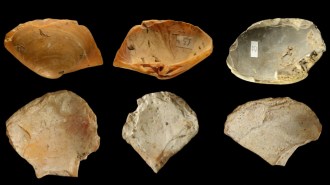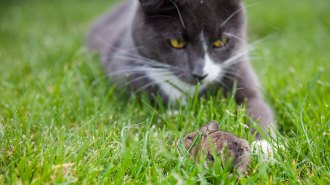All Stories
-
 Anthropology
AnthropologyNeandertals dove and harvested clamshells for tools near Italy’s shores
The discovery of sharpened shells broadens the reputation of Stone Age human relatives: Neandertals weren’t just one-trick mammoth hunters.
By Bruce Bower -
 Neuroscience
NeuroscienceA parasite that makes mice unafraid of cats may quash other fears too
The parasite Toxoplasma gondii can mess with all sorts of mice behaviors and make the rodents fearless in many situations.
-
 Microbes
MicrobesMicrobes slowed by one drug can rapidly develop resistance to another
Hunkering down in a dormant, tolerant state may make it easier for infectious bacteria to develop resistance to antibiotics.
-
 Archaeology
ArchaeologyAfter the Notre Dame fire, scientists get a glimpse of the cathedral’s origins
Researchers will tackle the scientific questions behind rebuilding Notre Dame, and learn more about its history.
-
 Space
SpaceThis ancient stardust is the oldest ever to be examined in a lab
Tiny grains of stardust that formed long before our solar system are giving new insight into star formation in the Milky Way.
-
 Physics
PhysicsThe fastest-spinning object ever made could help spot quantum friction in a vacuum
Scientists have developed a torque sensor made with a nanoparticle that can spin more than 300 billion times a minute.
-
 Animals
AnimalsAustralian fires have incinerated the habitats of up to 100 threatened species
Hundreds of fires that are blazing across the continent’s southeast have created an unprecedented ecological disaster, scientists say.
-

Readers react to rechargeable batteries and more
Readers had questions about lithium-ion batteries.
-

Scientists embrace a cathedral’s rebirth
Editor in Chief Nancy Shute discusses the science behind restoring Notre Dame's unique sound.
By Nancy Shute -
 Physics
PhysicsHow to restore the legendary acoustics of Notre Dame
Using heritage acoustics, researchers hope to help restore the sound of Paris's Notre Dame cathedral.
-
 Earth
EarthWildfires could flip parts of the Amazon from a carbon sponge to a source by 2050
Climate change and deforestation could double the area burned by fire in the southern Amazon by 2050, flipping the forest from carbon sponge to source.
-
 Health & Medicine
Health & MedicineWhat we know — and don’t know — about a new virus causing pneumonia in China
A newfound coronavirus is behind a mysterious outbreak of pneumonia in central China. Experts urge vigilance but say there’s no cause for panic.